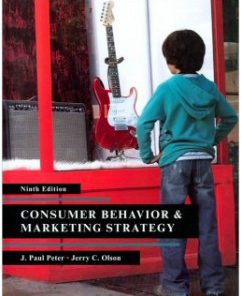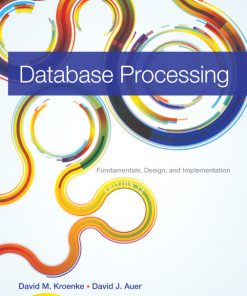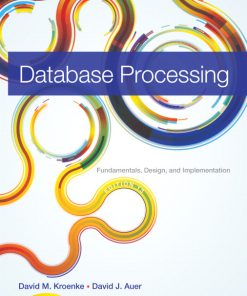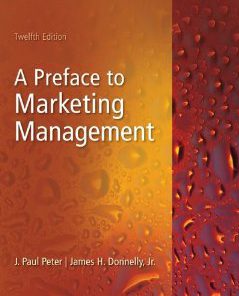Test Bank for Economic Way of Thinking, The, 13/E 13th Edition Paul L. Heyne Peter J. Boettke David L. Prychitko
$35.00 Original price was: $35.00.$26.50Current price is: $26.50.
Test Bank for Economic Way of Thinking, The, 13/E 13th Edition Paul L. Heyne, Peter J. Boettke, David L. Prychitko
This is completed downloadable of Test Bank for Economic Way of Thinking, The, 13/E 13th Edition Paul L. Heyne, Peter J. Boettke, David L. Prychitko
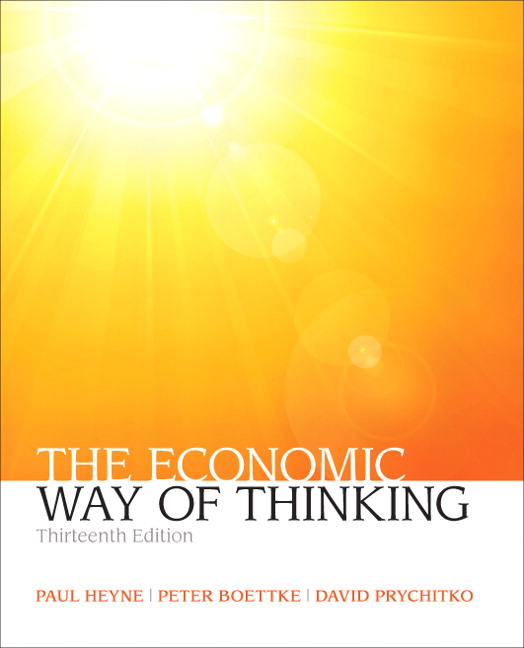
Product Details:
- ISBN-10 : 0132991292
- ISBN-13 : 978-0132991292
- Author: Paul Heyne, Peter Boettke, David Prychitko
Intended primarily for one semester survey courses in general economics, this text also provides practical content to current and aspiring industry professionals.
Learn how to think like an economist.
The Economic Way of Thinking goes beyond explaining the basic principles of micro- and macroeconomic analysis by showing readers a method of reasoning that teaches them how to apply these principles as tools. The authors expose readers to a method of reasoning that makes them think like an economist through example and application and also shows them how not to think, by exposing errors in popular economic reasoning.
The latest edition has been thoroughly updated with current material.
Table of Content:
Chapter 1 The Economic Way of Thinking
- Recognizing Order
- The Importance of Social Cooperation
- How Does It Happen?
- An Apparatus of the Mind–The Skill of the Economist
- Cooperation Through Mutual Adjustment
- Signals
- Rules of the Game
- Property Rights as Rules of the Game
- The Biases of Economic Theory: A Weakness or a Strength?
- Biases or Conclusions?
- The Skills of the Economist
- Questions for Discussion
Chapter 2 Efficiency, Exchange and Comparative Advantage
- Goods and Bads
- The Myth of Material Wealth
- Trade Creates Wealth
- Is It Worth It? Efficiency and Values
- Recognizing Trade-Offs: Comparing Opportunity Costs of Production
- The Gains from Specialization and Exchange
- Why Specialize?
- From Individual Trade to International Trade, and Back Again
- Transaction Costs
- Incentives to Reduce Transaction Costs: Middlemen
- Middlemen Create Information
- Markets as Discovery Processes
- The Big Picture: First Thoughts on Economic Growth
- Searching for an Explanation
- The Evolution of Rules That Encourage Specialization and Exchange
- Questions for Discussion
Chapter 3 Substitutes Everywhere: The Concept of Demand
- On the Notion of “Needs”
- Marginal Values
- Forks in the Road: Everyday Choices Are Marginal Choices
- The Demand Curve
- The Law of Demand
- Demand and Quantity Demanded
- Demand Itself Can Change
- Everything Depends on Everything Else
- Misperceptions Caused by Inflation
- Time Is on Our Side
- Price Elasticity of Demand
- Thinking About Elasticity
- Elasticity and Total Receipts
- The Myth of Vertical Demand
- What Role Should Demand Play?
- Is Money All That Matters? Money Costs, Other Costs, and Economic Calculation
- Questions for Discussion
Chapter 4 Cost and Choice: The Concept of Supply
- Refresher on Opportunity Costs
- Costs Are Tied to Actions, Not Things
- What Do I Do Now? The Irrelevance of “Sunk Costs”
- Producers’ Costs as Opportunity Costs
- Marginal Opportunity Costs
- Costs and Supply
- The Supply Curve
- Supply Itself Can Change
- Marginal and Average Costs
- The Cost of a Volunteer Military Force
- Price Elasticity of Supply
- Cost as Justification
- Questions for Discussion
Chapter 5 Supply and Demand: A Process of Coordination
- The Market Is a Process of Plan Coordination
- The Basic Process
- Competition, Cooperation, and Market Clearing
- Changing Market Conditions
- Learning from Free-Market Prices Central Planning and the Knowledge Problem
- Property Rights and Institutions
- Money: The General Medium of Exchange
- Money and Interest
- Time Preference
- Saving Creates Credit Opportunities
- The Risk Factor in Interest Rates
- Real and Nominal Interest Rates
- Questions for Discussion
Chapter 6 Unintended Consequences: More Applications of Supply and Demand
- Catastrophe and Confusion
- Catastrophe and Coordination
- The Urge to Fix Prices
- Competition When Prices Are Fixed
- Appropriate and Inappropriate Signals
- Looking for an Apartment in the City? Read the Obituary!
- Strong Booze, Stronger Drugs: Criminal Incentives
- Skim Milk, Whole Milk, and Gangster Milkmen
- Supports and Surpluses
- Supply, Demand, and the Minimum Wage
- Slavery Goes Global, Again
- High-Priced Sports, Low-Priced Poetry: Who’s to Blame?
- Do Costs Determine Prices?
- The Dropouts Release Their First CD
- “There’s Gold in Them Thar Hills!” So What?
- Even Butchers Don’t Have the Guts
- Why Does It Cost So Much to Change Bedpans?
- An Appendix: Framing Economic Questions Correctly
- Beware of Wrong Questions or Misleading Specifications of the Problem
- Beware of Data That Appear to Speak for Themselves
- The Graphic Case of Growing and Permanent Shortages
- Once Over Lightly
- Questions for Discussion
Chapter 7 Profit and Loss
- Wage, Rent, and Interest: Incomes Established in Advance by Contract
- Profit: Income That Can Be Positive or Negative
- Calculating Profit: What Should Be Included in Costs?
- Comparing Economic Profit and Accounting Profit
- Uncertainty: A Necessary Condition for Profit
- The Entrepreneur
- The Entrepreneur as Residual Claimant
- Not-for-Profit Institutions
- Entrepreneurship and the Market Process
- Mere Luck?
- Profit and Loss as Coordinating Signals: The Role of Monetary Calculation
- Beware of Experts
- An Appendix: Profiteering in Futures Markets
- Questions for Discussion
Chapter 8 Price Searching
- The Popular Theory of Price Setting
- Introducing Ed Sike
- The Basic Rule for Maximizing Net Revenue
- The Concept of Marginal Revenue
- Why Marginal Revenue Is Less Than Price
- Setting Marginal Revenue to Equal Marginal Cost
- What About Those Empty Seats?
- The Price Discriminator’s Dilemma
- The College as Price Searcher
- Some Strategies for Price Discrimination
- Ed Sike Finds a Way
- Resentment and Rationale
- Lunch and Dinner Prices
- Cost-Plus-Markup Reconsidered
- Questions for Discussion
Chapter 9 Competition and Government Policy
- Competition as a Process
- The Pressures of Competition
- Controlling Competition
- Restrictions on Competition
- Competition for the Key Resource: The $1,000,000 Taxi License
- Competition and Property Rights
- The Ambivalence of Government Policies
- Selling Below Cost
- What Is the Appropriate Cost?
- “Predators” and Competition
- Regulating Prices
- “Antitrust” Policy
- Interpretations and Applications
- Vertical Restraints: Competitive or Anticompetitive
- The Range of Opinion
- Toward Evaluation
- Once Over Lightly
- Questions for Discussion
Chapter 10 Externalities and Conflicting Rights
- Externalities, Negative and Positive
- Perfection Is Unattainable
- Negotiation
- Reducing Externalities Through Adjudication
- The Case of the Complaining Homeowner
- The Importance of Precedents
- The Problem of Radical Change
- Reducing Externalities Through Legislation
- Minimizing Costs
- Another Approach: Taxing Emissions
- Licenses to Pollute?
- Efficiency and Fairness
- The Bubble Concept
- Rights and the Social Problem of Pollution
- Traffic Congestion as an Externality
- Once Over Lightly
- Questions for Discussion
Chapter 11 Markets and Government
- Private Versus Public?
- Competition and Individualism
- Economic Theory and Government Action
- The Right to Use Coercion
- Is Government Necessary?
- Excluding Nonpayers
- The Free-Rider Problem
- Positive Externalities and Free Riders
- Law and Order
- National Defense
- Roads and Schools
- Income Redistribution
- The Regulation of Voluntary Exchange
- Government and the Public Interest
- Information and Democratic Governments
- The Interests of Elected Officials
- Concentrated Benefits, Dispersed Costs
- Positive Externalities and Government Policies
- How Do People Identify the Public Interest?
- The Prisoners’ Dilemma
- The Limits of Political Institutions
- Once Over Lightly
- Questions for Discussion
Chapter 12 the Distribution of Income
- Suppliers and Demanders
- Capital and Human Resources
- Human Capital and Investment
- Property Rights and Income
- Actual, Legal, and Moral Rights
- Expectations and Investment
- People or Machines?
- The Derived Demand for Productive Services
- Who Competes Against Whom?
- Unions and Competition
- Poverty and Inequality
- Why Inequality Is Increasing
- Are the Rich Getting Richer and the Poor Getting Poorer?
- Redistributing Income
- Changing Rules and Social Cooperation
- Once Over Lightly
Chapter 13 Measuring the Overall Performance of Economic Systems
- Gross Domestic Product
- GDP or GNP?
- GDP as Total Income Created in the Domestic Economy
- GDP Is Not a Measure of All Purchases in the Economy
- GDP as Total Value Added
- Is Value Added Always Positive?
- Loose Ends: Unsold Inventories and Used Goods
- Aggregate Fluctuations
- Unemployment and Nonemployment
- Employed, Not Employed, and Unemployed
- Labor-Market Decisions
- Unemployment and Recessions
- Inflation
- Recession and Inflation Since 1960
- What Causes Aggregate Fluctuations?
Chapter 14 Money
- The Evolution of Money
- The Myth of Fiat Money
- The Nature of Money Today
- So How Much Money Is Out There?
- Credibility and Confidence
- Banks Under Regulation: Legal Reserve Requirements
- Deposit Expansion and the Creation of Money
- The Fed as Monitor and Rule Enforcer
- The Tools Used by the Fed
- The Discount Rate
- Open Market Operations
- Monetary Equilibrium
- But Who Is Really in Charge?
- An Appendix: What About Gold?
- Once Over Lightly
Chapter 15 Economic Performance and Real-World Politics
- The Great Depression
- What Really Happens in a Recession?
- A Cluster of Errors
- Credit and Coordination: Savings and Investment in the Free Market
- Credit and Discoordination: The Unsustainable Boom
- The Recession is the Correction
- When Is Monetary Policy Effective?
- The Case for Fiscal Policy
- The Necessity of Good Timing
- The Federal Budget as a Policy Tool
- Time Horizons and Politics
- Deficits Unlimited
- Why Not Government at All Levels?
- Who Is at the Controls?
- Understanding Recent Experience
- Once Over Lightly
Chapter 16 The Wealth of Nations: Globalization and Economic Growth
- Who Is Rich, Who Is Poor?
- The Historical Record
- Sources of Economic Growth
- Foreign Investment
- Human Capital
- Oil Comes from Our Minds
- Economic Freedom Index
- The Developmental Power of Private Property Rights
- The Asian Record
- Outside of Asia
- The Difficulties of International GDP Comparisons
- Globalization and Its Discontents
- The Power of Popular Opinion
- The Power of Special Interests
- The Outsourcing Controversy: Soundbytes vs. Analysis
- Once Over Lightly
People Also Search:
the economic way of thinking 13th edition
the economic way of thinking 13th edition pdf free
economic way of thinking, the, 13/e 13th
You may also like…
Solution Manual
Solution Manual for Engineering Mechanics, Statics, 7th Edition, J. L. Meriam, L. G. Kraige
Solution Manual
Solution Manual for Inorganic Chemistry, 5/E, Gary L. Miessler, Paul J. Fischer Donald A. Tarr





